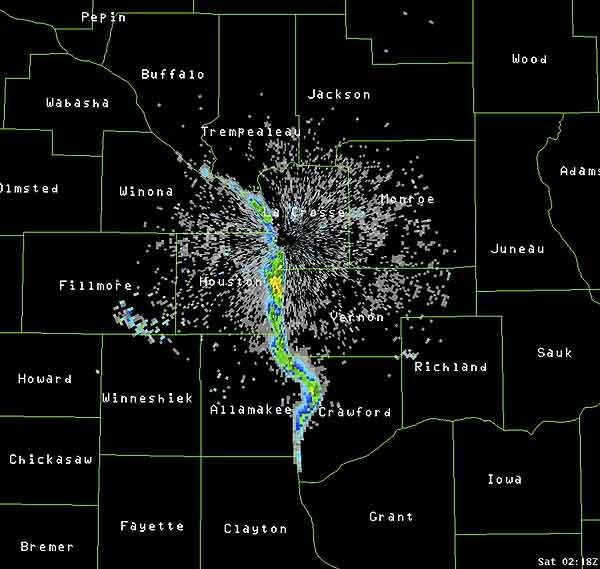Fri 7 Jul 2006

This radar image from the National Weather Service shows a gigantic hatch of mayflies last Friday evening along the Mississippi River in portions of Wisconsin, Iowa and Minnesota. (Photo/AP)
LEE BERGQUIST (lbergquist journalsentinel com), Milwaukee Journal Sentinel, reports:
It wasn’t rain. It certainly wasn’t snow.
So what was it last Friday that turned the radar in the La Crosse area into a sea of white?
It turns out that it was a gigantic hatch of mayflies.
The bugs were so thick that they showed up as a rainstorm of mayflies on National Weather Service radar.
For about 1 1/2 hours starting at 9 p.m., the insects drifted north, with the radar showing them blanketing areas along the Mississippi River.
“They were dive-bombing in the root beer floats,” said Gary Rudy, owner of Rudy’s Drive-In, whose family has been slinging burgers and soft drinks since 1966.
“It hasn’t been that bad in a long time.”
At Riverfest, the city’s summer festival, the mayflies were buzzing revelers, and folks were scraping the insects off the bottoms of their shoes.
“They have a fishy smell when you step on them,” said Gar Amunson, superintendent of parks for the city. “They are an annoyance.”
The weather service reported that “some roads across the Mississippi River in and around La Crosse were covered with bugs, piling into ‘drifts’ on bridges over the Mississippi River and its tributaries.”
“Local businesses with high intensity lighting soon found large piles of dead mayflies accumulating under the lights by midnight.”
And yet the swarms of mayflies are considered to be down from decades ago, when city crews pulled out plows to mop up after a large hatch, Amunson said.
Large numbers have showed up elsewhere in recent years, including a large emergence on Lake Erie last summer, said Mike Miller, a stream ecologist with the state Department of Natural Resources.
Why all the hubbub this year?
In fact, mayflies are a common sight along the Mississippi and many other water bodies where nymphs spend most of their lives in sediment, then hatch and float to the top of the water column.
This year, however, they were caught on radar.
Miller says that improved water quality on the Mississippi might be one reason for a general increase in numbers over the past decade.
But mayflies are still imperiled by the changing character of the river, said Cindy Koperski, a water quality biologist with the DNR. That’s because the insects have lost habitat - in their case, they have lost sediment - as pools of river water behind locks and dams have grown larger, covering up exposed areas over time, she said.
Mayflies are a seasonal phenomenon and come into their glory in late June to early July.
It is during this period of hedonistic frenzy that they leave the water, and mate in a sudden burst of aerial theatrics before dying.
Friday night just happened to be, well, a Friday night.